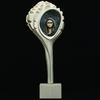The Birth of a Creative Empire on View in “Louis C. Tiffany and the Art of Devotion”
- NEW YORK, New York
- /
- November 15, 2012

Previously unexamined works by Louis C. Tiffany and his studio are now the subject of a major loan exhibition at the Museum of Biblical Art (MOBIA) in New York City through January 20, 2013.
“Louis C. Tiffany and the Art of Devotion” brings together over 80 works of art, including stained glass windows, mosaics, ecclesiastical objects, preparatory drawings, and archival materials that span the mid-1880s through the mid-1910s. The result is a revealing and panoramic look Tiffany’s core business during the period as he and his studio created untold thousands of objects for houses of worship throughout the United States and cemented the foundation of one of America’s great artistic stories.
Although best known today for his floor and table lamps and desk sets (his successful father, Charles, had already founded the jewelry business when Tiffany was a young child), Louis Comfort Tiffany (1848 – 1933) had been an artist and interior designer before launching the Tiffany Glass Company in 1885. Recognizing the tremendous growth in America’s congregations – over 4,000 were established between 1880 and 1906 – in 1889 Tiffany created an ecclesiastical division within his company and in 1893 created a chapel-like showroom at the World’s Columbian Exposition in Chicago, an installation that won numerous awards and won Tiffany international fame.
During the following three decades, ecclesiastical commissions were the central business of Tiffany Glass Company, which was renamed Tiffany Studios in 1902.
“Louis C. Tiffany and the Art of Devotion” draws on loans from over a dozen museums and archives as well as from private collections and churches. Tiffany also created commissions for nearly a dozen synagogues, and while none are in the exhibition for logistical reasons, the museum has arranged for tours of Temple Emanu-el on Fifth Avenue, including its May Memorial Window: see programming information below. The exhibition presents preparatory drawings and materials that illuminate the working process and exacting standards of Tiffany Studios as well as dozens of fully-realized works. Among them is a striking baptismal font, accompanied by numerous design sketches for fonts, that was commissioned in memory of a woman’s late husband and late child and a stained glass window and a larger-than-life size mosaic fabricated for the 1893 Columbian Exposition.
Rather than paint on clear glass in the European tradition that was continued in the United States, Tiffany used colored glass, and notably opalescent glass, to add visual dimension. He specialized in the manipulation of the hot glass itself, creating nearly bas-relief depth, feathered surfaces, dimples, and a range of other textures.
The exhibition offers an exceptional opportunity to view Tiffany’s mastery of the material. The windows are seen at eye level rather than elevated, as is typically found in churches and synagogues. And the details of the work are enhanced because the windows are lit evenly from behind by LED panels equal in size to the windows themselves.
Among the highlights of the exhibition is The Righteous Shall Receive a Crown of Glory, circa 1901, a massive 12-foot-tall window that draws on the pre-Raphaelite school in artistic style and is a distillation of many of Tiffany’s glass working techniques. On loan from the Corning Museum of Glass, Corning, New York, the window is included in the exhibition through a multi-museum collaboration: it was restored by Drew Anderson, Conservator in the Sherman Fairchild Center for Objects Conservation at the Metropolitan Museum of Art; The Neustadt Collection of Tiffany Glass, Long Island City, New York, provided studio space for the restoration; and MOBIA underwrote the conservation work. The window is being exhibited publicly for the first time in decades.
A visual omnivore, Tiffany drew on a remarkable range of artistic styles for inspiration in creating his works. Chalices from medieval Siena are referenced in a suite of liturgical objects (ca. 1916) on loan from Christ Church, in Cobble Hill, Brooklyn.
The Sir Galahad, Cryder Memorial Window (before 1910) presents a youth in armor by a white horse – a symbol of purity – in a palette of blues and greens. Created in memory of Ogden Cryder, who was killed by a trolley car while in his teens, the window is one of the few on loan from a church, St. Andrew’s Dune Church, Southampton, New York. It was available for loan because the church had years ago made its windows removable to protect them during instances of severe weather.
Catalogue
The accompanying scholarly exhibition catalogue ($55.00) is co-published by D Giles Limited of London, with contributions from co-curators Patricia C. Pongracz, Ph.D., catalogue editor and Acting Director and Director of Curatorial Affairs, MOBIA; Lindsy Parrott, Director/Curator, The Neustadt Collection of Tiffany Glass; and Diane Wright and Elizabeth De Rosa, Ph.D., independent scholars of American Decorative Art. The catalogue also includes contributions from leading experts in the field, including: Jennifer Perry Thalheimer, Curator and Collections Manager at the Charles Hosmer Morse Museum of American Art in Winter Park, Florida; Elka Deitsch, Senior Curator, Herbert & Eileen Bernard Museum of Judaica at Congregation Emanu-El; Alice Cooney Frelinghuysen, Anthony W. and Lulu C. Wang Curator of American Decorative Arts, The Metropolitan Museum of Art; and Peter W. Williams, Distinguished Professor of Comparative Religion and American Studies, Miami University, Oxford, Ohio and Bexley Hall Seminary, Columbus, Ohio,
Funding for Louis C. Tiffany and the Art of Devotion
Major support for MOBIA’s exhibitions and programs has been provided by American Bible Society and by Howard and Roberta Ahmanson. Louis C. Tiffany and the Art of Devotion is made possible by the generous support of the Henry Luce Foundation, the Elizabeth Morse Genius Foundation, North Avenue Presbyterian Church, Atlanta, and the Corning Incorporated Foundation. The exhibition is also supported by public funds from the New York City Department of Cultural Affairs in partnership with the City Council and the New York State Council on the Arts with the support of Governor Andrew Cuomo and the New York State Legislature. MOBIA acknowledges the support of the Neustadt Collection of Tiffany Glass for conservation studio and storage space. Support for children’s educational programs is provided, in part, by TD Charitable Foundation.
About MOBIA
Located near Lincoln Center, MOBIA celebrates and interprets art related to the Bible and its cultural legacy in Jewish and Christian traditions through exhibitions, education and scholarship. For more information, please visit www.mobia.org.
Contact:
Andrew DeckerAndrew Decker Communications
212-222-4688
decker06@gmail.com












100x100_c.jpg)



